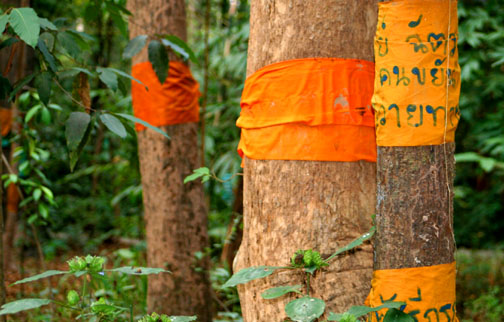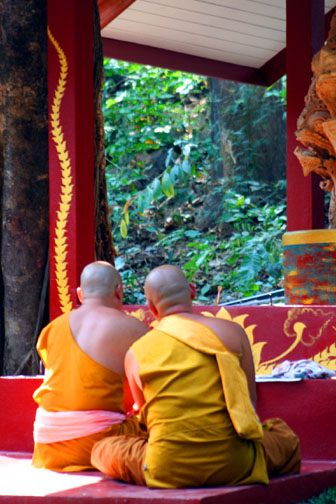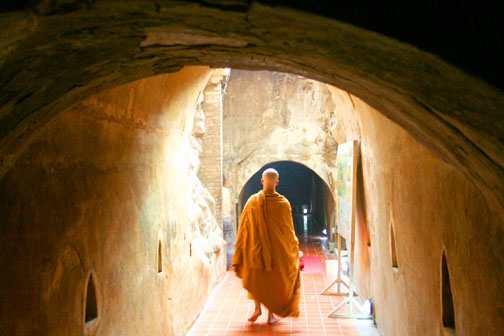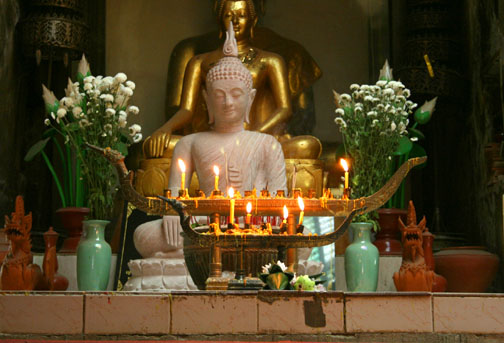Tags
“I have not failed – I found ways that don’t work.”
Aphorisms to live by, or at least to meditate upon, appear frequently on hand lettered signs attached to the trees along the forested trail through the grounds of Wat U-Mong in Chiang Mai. All are in Thai, some also translated into English. I understand the sentiment of “Today Is Better Than Two Tomorrows.” But then tomorrow I might win the lottery, so I quickly discard that bit of advice. I appreciated the Confucius sounding “Cut yourself some slack. Remember, One hundred years from now, All new people,” but then I always appreciate any excuse for a lack of goals, mistakes and errors, or bad behavior.
Wat U-Mong is a meditation temple, the fortune cookie like sayings posted on saffron sashed trees are supposed to give you cause to reflect. The large faded poster of dogs smoking, drinking, and shooting pool provided me the longest period of contemplation during my visit. A warning? Enticement? Advertisement for an upcoming event? Its inclusion remains a mystery to me, but a bit of whimsy is not unknown at Thailand’s temples. Dogs having fun aside, Wat U-Mong is one of the most unique temples I’ve visited in Thailand, and I spent hours longer there than I’d planned.
Wat U-Mong has been on my list of places to visit while in Chiang Mai for years. Usually my visits to the city are only for a few days. There is lots to do and see in the area, so the wat remained on my ‘one of these days’ list. I’d seen a few photos, the place looked cool, but not so cool I just had to get there. There are lots of wats in and around Chiang Mai. It’s not like you’d be starving for one to visit. But I finally made it there last year. And could kick myself for not having done so before.
Off Suthep Road, Wat U-Mong is not right in town. But not that far outside either. Maybe a ten minute ride from the Thae Pae gate area. Since there is no admission fee – and no accompanying kickback for a taxi or tuk tuk driver – there’s no incentive for a driver to take you there. Or hang while you check it out. It’s far enough off the beaten path that you’d want a ride waiting for you when you are done: the wat is not a hang out for drivers looking to score a fare. I’d used a private car a few days already on the trip, so even though Mr. Ot, my driver, was hoping for a more extensive day of chauffeuring me about, he agreed to the short trip.
There’s not a lot of info about the Wat U-Mong on-line. It’s not one of the more popular temples in the area. Most free maps available in town don’t even show it. What info you will find on the ‘net tells you the wat is a series of tunnels. Could be cool. Could be dank, dark, and not worth the trip. There’s also mention of a unique emanciated Buddha statue, accompanying photos look like it was the inspiration for creature in Aliens. Not the glowing recommendation other wats in Chiang Mai get. I think the monks at Wat U-Mong like it that way. Maybe I’m screwing with my karma by telling you about the place.
The dusty clearing used as a parking lot off the main road doesn’t promise much; the large billboard-sized map holds few clues to what you’ll find within the 15 acres of grounds. But does lead me to believe that whatever path I take will eventually bring me back to Ot and my ride back into town. It looks like I’ll spend and hour or less seeing the sights within and just as I’m about to tell Ot about my timetable I realize he’s already stretching out for a nap and could care less how long I take. So off I wander down a dirt path that curves its way through a small forest of trees, a quiet walk momentarily broken by the screech of birds not happy with my intrusion into their world.
Trees tied with saffron robes lettered with blue blessings appear quite frequently. As the path starts up a slight incline, the first of the lettered wooden signs appear. It’s a good ten minutes stroll before any structures appear, but they are not religious in nature, possibly residences or meeting halls. I’ve yet to see a monk, a stupa, or even a small shrine. So far, as a peaceful stroll through the forest the wat excels; as a Buddhist sanctuary it sucks.
But that changes quickly at the first junction of paths. Ahead is a stone set of stairs flanked by carved nagas, the tip of a chedi visible at the top. To the right, a path leads downhill and a glimpse of a white Buddha head draws me to a small clearing with a few statutes nestled between the trees. A tranquil lake, with the only other humans I’ve seen so far, is just a bit further down the path. The placid water and shaded shore are an inviting rest-stop. For a mere 10 baht you can buy food to feed the fish, a cheap way to make merit, a cheap excuse to laze about for a while. There are turtles, too, quite a large colony of them and they are more responsive to food thrown their way. My first Buddhist related thought of the day is that it’s got to be better to be reincarnated as a turtle than a fish, but what degree of behavior in your life would nudge you toward having four legs instead of a pair of fins?
Evidently it has nothing to do with over eating or smoking; back up the trail next to the stairs a pair of monks are busy painting a red pagoda with gold leaf lotus blossoms. Both are fat. Both have cigarettes going. Both are old enough that I have to assume the rules of the temple allow elders to seek their own path of enlightenment, as long as they are busy with work needing to be done. At the top of the stairs a circular grassy area surrounds an imposing chedi, a large bronze bell the only other structure. A low wall encircles the area, providing shade and a place to sit. I think I have the area to myself until a damn temple cat starts rubbing its head on my pant leg demanding attention. Peace, quiet, and cooling shade shattered by feline demands, maybe there’s a Buddhist lesson there. Maybe I can make a donation to have a meditation sign hung saying “Don’t trust the cats; they’re only in it for themselves.”
Back down the stairs to the left the wat’s main attraction finally appears. The tunnels, what this temple is primarily known for. According to legend, a king built the brick-lined tunnels for a clairvoyant but sometimes eccentric monk named Thera Jan. Some tales conclude the tunnels offered the monk a place of isolation where he could quietly meditate; others a maze to keep him from wandering off and getting lost in the forest. If the maze story is the right one, his mental state must have been pretty far gone. One entrance leads through the underground temple, up a dark flight of stairs and out to where the Alien Buddha statute awaits. The other leads into a shrine area and then connects to the aforementioned entrance. Not much of a maze. But far more fascinating than any descriptions of the wat I’d read before my visit.
The main shrine area is lit from above, a natural skylight shinning sunlight down into the temple’s interior. The tunnel walls and floors are brick lined, clean, and straight. The flashlight guide books suggest bringing is unnecessary. Except for the low ceilinged short flight of stairs that lead to two smaller shrines areas and the uphill exit there is ample natural light. Touri on the run can make it through the entire underground temple in less than five minutes. I spent a good hour circling through the tunnels, lining up shots, enjoying the coolness, and chasing a monk who appeared out of the dark. Negative thoughts about the cat aside, my karma meter was on the positive side, I got a great monk shot, one of my favorite from the trip.
Back outside is a small area filled with broken statutes. Monks from the wat collected the big Buddha head and other Buddha images from deserted monasteries in Phayao province during the late ‘60s. Since then the collection has grown, serving as a graveyard, a field of broken sculpture and unwanted religious statutes. A barely delineated path leads through the statuary, at its far side a large gathering of wood buildings serve as residences for the temple’s monks. This is also where visitors stay during the three to ten day meditation courses offered by the temple. It’s also home to a large family of dogs, their primary responsibility a counter balance to the negativity of the Stupa cat I’m sure.
The road back out to the world is again heavily forested. As I make my way down the path the temple’s monks have gathered and begin their evening chants which echo through the trees. I doubt my visit has furthered me along my path to enlightenment, but my hour long trip turned into a four hour journey and there is no denying that the temple’s magic has brought some peace to my soul.
Related Posts You Might Enjoy:










